Case Study Analysis: Health Variations and Crohn's Disease Impact
VerifiedAdded on 2022/09/06
|9
|2310
|28
Homework Assignment
AI Summary
This assignment analyzes a case study of a 25-year-old male diagnosed with Crohn's disease, focusing on the structural and functional changes leading to weight loss, the pain pathway and morphine's effect on pain perception, clinical manifestations indicating disease deterioration, and the characteristics and rationale for intravenous fluid administration. The solution explores the inflammatory bowel disease's impact, including malnutrition, hormonal changes, and malabsorption. It details the pain pathway, explaining transduction, transmission, modulation, and perception, along with morphine's mechanism of action. The assignment further examines symptoms like persistent diarrhea, nausea, vomiting, and reluctance to eat, linking them to the worsening Crohn's condition. Finally, it describes the characteristics of Hartman's solution, an intravenous fluid, and explains its rationale for restoring electrolyte balance and maintaining pH levels, providing a holistic understanding of the patient's condition and treatment.
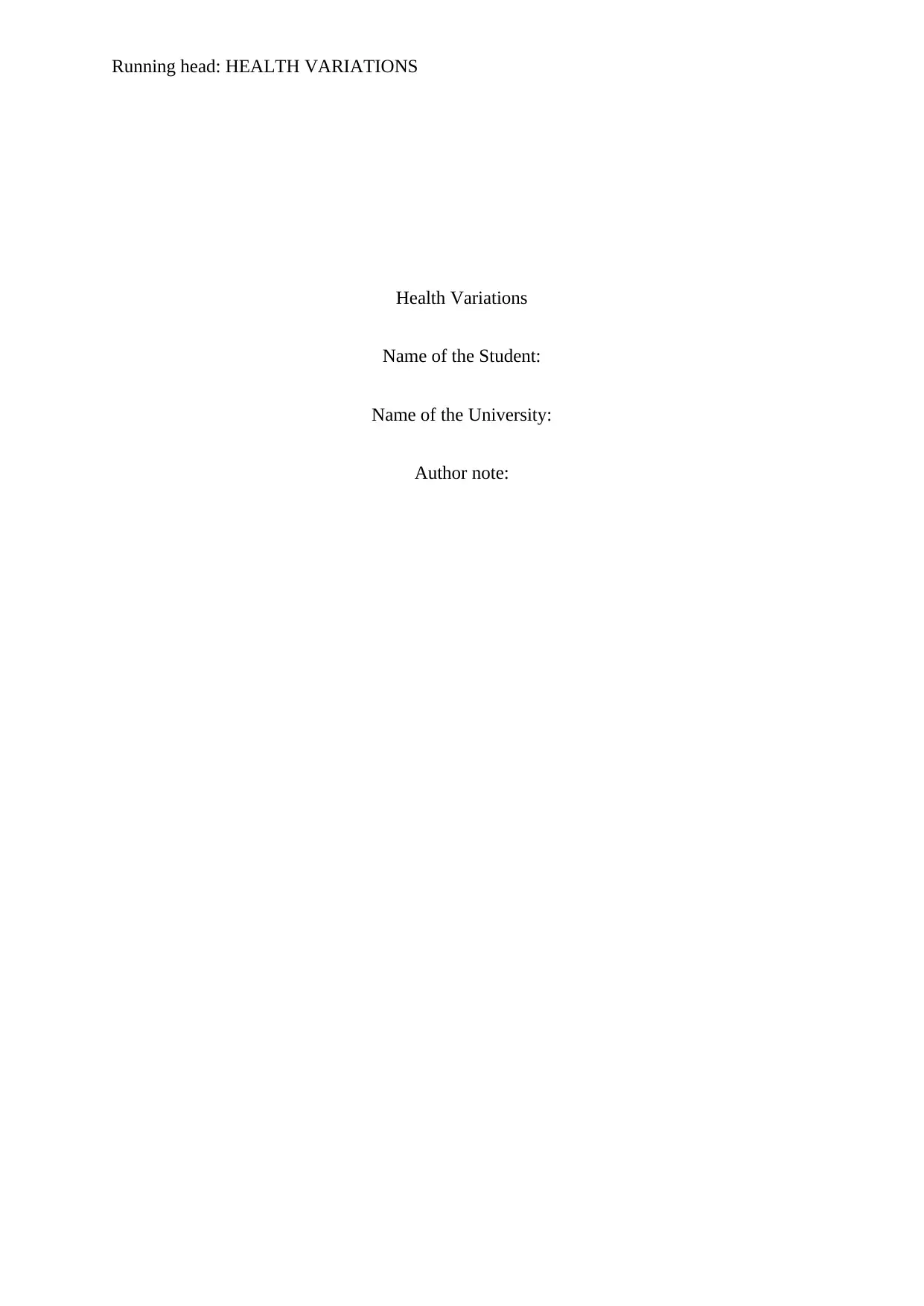
Running head: HEALTH VARIATIONS
Health Variations
Name of the Student:
Name of the University:
Author note:
Health Variations
Name of the Student:
Name of the University:
Author note:
Paraphrase This Document
Need a fresh take? Get an instant paraphrase of this document with our AI Paraphraser
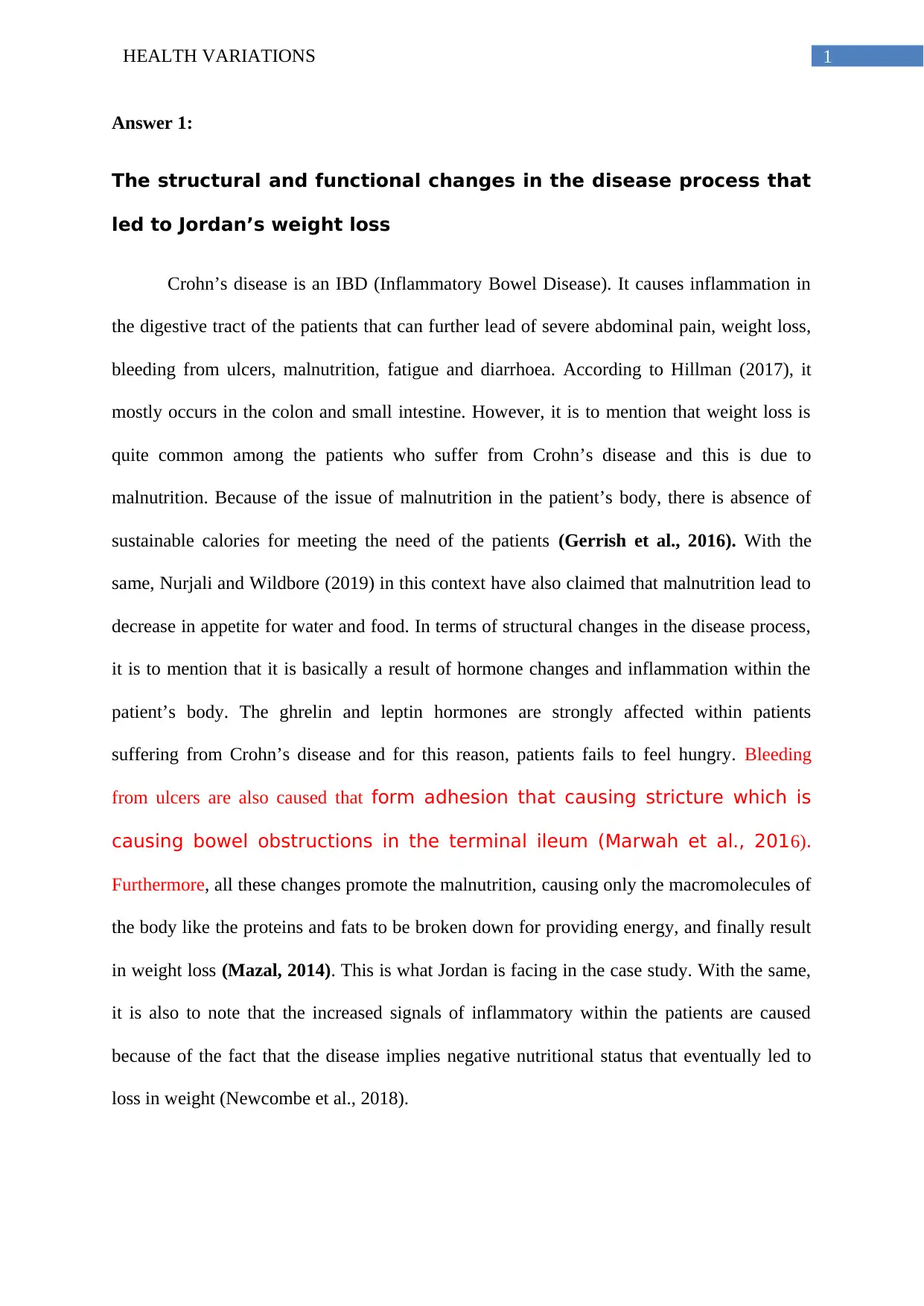
1HEALTH VARIATIONS
Answer 1:
The structural and functional changes in the disease process that
led to Jordan’s weight loss
Crohn’s disease is an IBD (Inflammatory Bowel Disease). It causes inflammation in
the digestive tract of the patients that can further lead of severe abdominal pain, weight loss,
bleeding from ulcers, malnutrition, fatigue and diarrhoea. According to Hillman (2017), it
mostly occurs in the colon and small intestine. However, it is to mention that weight loss is
quite common among the patients who suffer from Crohn’s disease and this is due to
malnutrition. Because of the issue of malnutrition in the patient’s body, there is absence of
sustainable calories for meeting the need of the patients (Gerrish et al., 2016). With the
same, Nurjali and Wildbore (2019) in this context have also claimed that malnutrition lead to
decrease in appetite for water and food. In terms of structural changes in the disease process,
it is to mention that it is basically a result of hormone changes and inflammation within the
patient’s body. The ghrelin and leptin hormones are strongly affected within patients
suffering from Crohn’s disease and for this reason, patients fails to feel hungry. Bleeding
from ulcers are also caused that form adhesion that causing stricture which is
causing bowel obstructions in the terminal ileum (Marwah et al., 2016).
Furthermore, all these changes promote the malnutrition, causing only the macromolecules of
the body like the proteins and fats to be broken down for providing energy, and finally result
in weight loss (Mazal, 2014). This is what Jordan is facing in the case study. With the same,
it is also to note that the increased signals of inflammatory within the patients are caused
because of the fact that the disease implies negative nutritional status that eventually led to
loss in weight (Newcombe et al., 2018).
Answer 1:
The structural and functional changes in the disease process that
led to Jordan’s weight loss
Crohn’s disease is an IBD (Inflammatory Bowel Disease). It causes inflammation in
the digestive tract of the patients that can further lead of severe abdominal pain, weight loss,
bleeding from ulcers, malnutrition, fatigue and diarrhoea. According to Hillman (2017), it
mostly occurs in the colon and small intestine. However, it is to mention that weight loss is
quite common among the patients who suffer from Crohn’s disease and this is due to
malnutrition. Because of the issue of malnutrition in the patient’s body, there is absence of
sustainable calories for meeting the need of the patients (Gerrish et al., 2016). With the
same, Nurjali and Wildbore (2019) in this context have also claimed that malnutrition lead to
decrease in appetite for water and food. In terms of structural changes in the disease process,
it is to mention that it is basically a result of hormone changes and inflammation within the
patient’s body. The ghrelin and leptin hormones are strongly affected within patients
suffering from Crohn’s disease and for this reason, patients fails to feel hungry. Bleeding
from ulcers are also caused that form adhesion that causing stricture which is
causing bowel obstructions in the terminal ileum (Marwah et al., 2016).
Furthermore, all these changes promote the malnutrition, causing only the macromolecules of
the body like the proteins and fats to be broken down for providing energy, and finally result
in weight loss (Mazal, 2014). This is what Jordan is facing in the case study. With the same,
it is also to note that the increased signals of inflammatory within the patients are caused
because of the fact that the disease implies negative nutritional status that eventually led to
loss in weight (Newcombe et al., 2018).
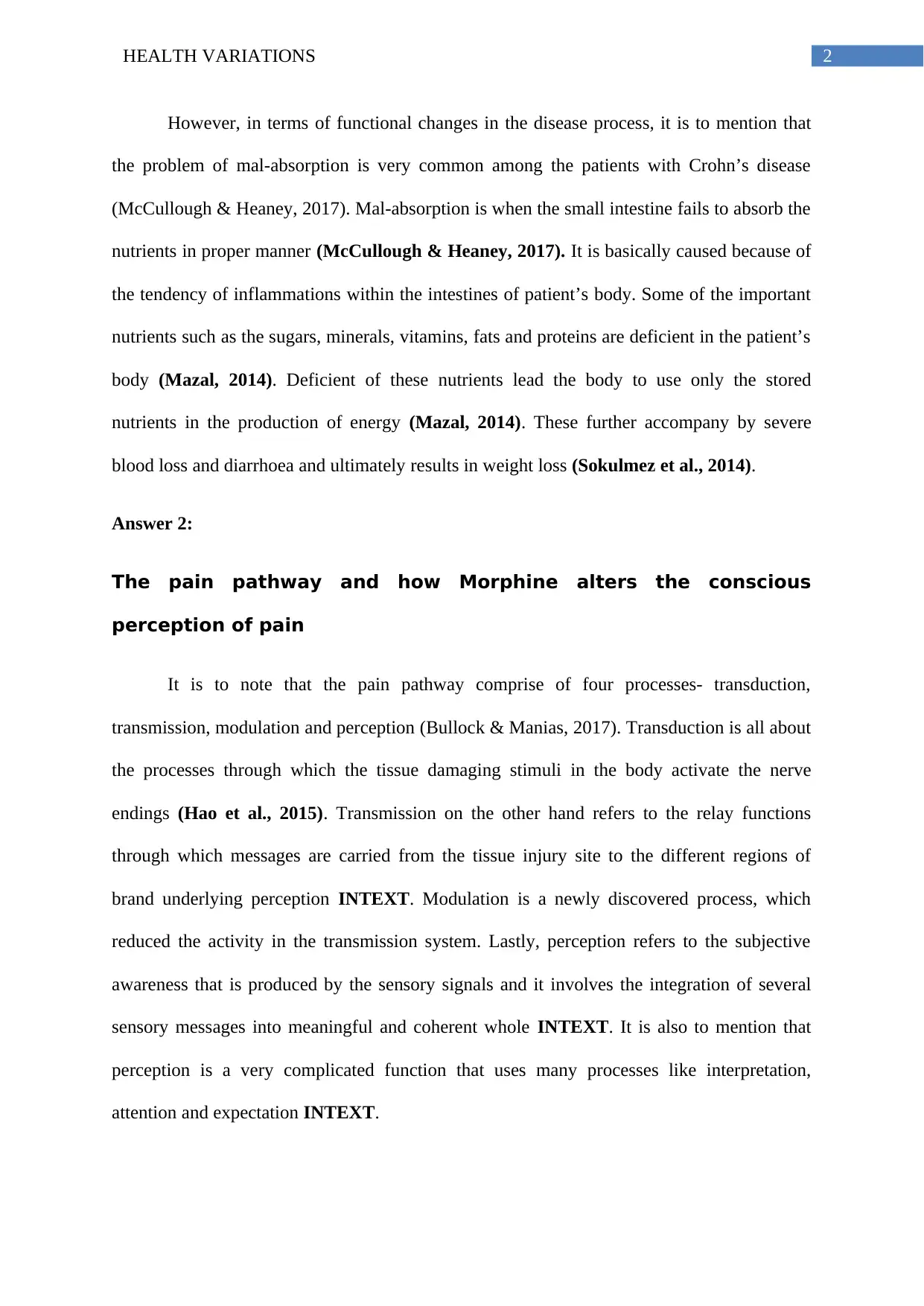
2HEALTH VARIATIONS
However, in terms of functional changes in the disease process, it is to mention that
the problem of mal-absorption is very common among the patients with Crohn’s disease
(McCullough & Heaney, 2017). Mal-absorption is when the small intestine fails to absorb the
nutrients in proper manner (McCullough & Heaney, 2017). It is basically caused because of
the tendency of inflammations within the intestines of patient’s body. Some of the important
nutrients such as the sugars, minerals, vitamins, fats and proteins are deficient in the patient’s
body (Mazal, 2014). Deficient of these nutrients lead the body to use only the stored
nutrients in the production of energy (Mazal, 2014). These further accompany by severe
blood loss and diarrhoea and ultimately results in weight loss (Sokulmez et al., 2014).
Answer 2:
The pain pathway and how Morphine alters the conscious
perception of pain
It is to note that the pain pathway comprise of four processes- transduction,
transmission, modulation and perception (Bullock & Manias, 2017). Transduction is all about
the processes through which the tissue damaging stimuli in the body activate the nerve
endings (Hao et al., 2015). Transmission on the other hand refers to the relay functions
through which messages are carried from the tissue injury site to the different regions of
brand underlying perception INTEXT. Modulation is a newly discovered process, which
reduced the activity in the transmission system. Lastly, perception refers to the subjective
awareness that is produced by the sensory signals and it involves the integration of several
sensory messages into meaningful and coherent whole INTEXT. It is also to mention that
perception is a very complicated function that uses many processes like interpretation,
attention and expectation INTEXT.
However, in terms of functional changes in the disease process, it is to mention that
the problem of mal-absorption is very common among the patients with Crohn’s disease
(McCullough & Heaney, 2017). Mal-absorption is when the small intestine fails to absorb the
nutrients in proper manner (McCullough & Heaney, 2017). It is basically caused because of
the tendency of inflammations within the intestines of patient’s body. Some of the important
nutrients such as the sugars, minerals, vitamins, fats and proteins are deficient in the patient’s
body (Mazal, 2014). Deficient of these nutrients lead the body to use only the stored
nutrients in the production of energy (Mazal, 2014). These further accompany by severe
blood loss and diarrhoea and ultimately results in weight loss (Sokulmez et al., 2014).
Answer 2:
The pain pathway and how Morphine alters the conscious
perception of pain
It is to note that the pain pathway comprise of four processes- transduction,
transmission, modulation and perception (Bullock & Manias, 2017). Transduction is all about
the processes through which the tissue damaging stimuli in the body activate the nerve
endings (Hao et al., 2015). Transmission on the other hand refers to the relay functions
through which messages are carried from the tissue injury site to the different regions of
brand underlying perception INTEXT. Modulation is a newly discovered process, which
reduced the activity in the transmission system. Lastly, perception refers to the subjective
awareness that is produced by the sensory signals and it involves the integration of several
sensory messages into meaningful and coherent whole INTEXT. It is also to mention that
perception is a very complicated function that uses many processes like interpretation,
attention and expectation INTEXT.
⊘ This is a preview!⊘
Do you want full access?
Subscribe today to unlock all pages.

Trusted by 1+ million students worldwide
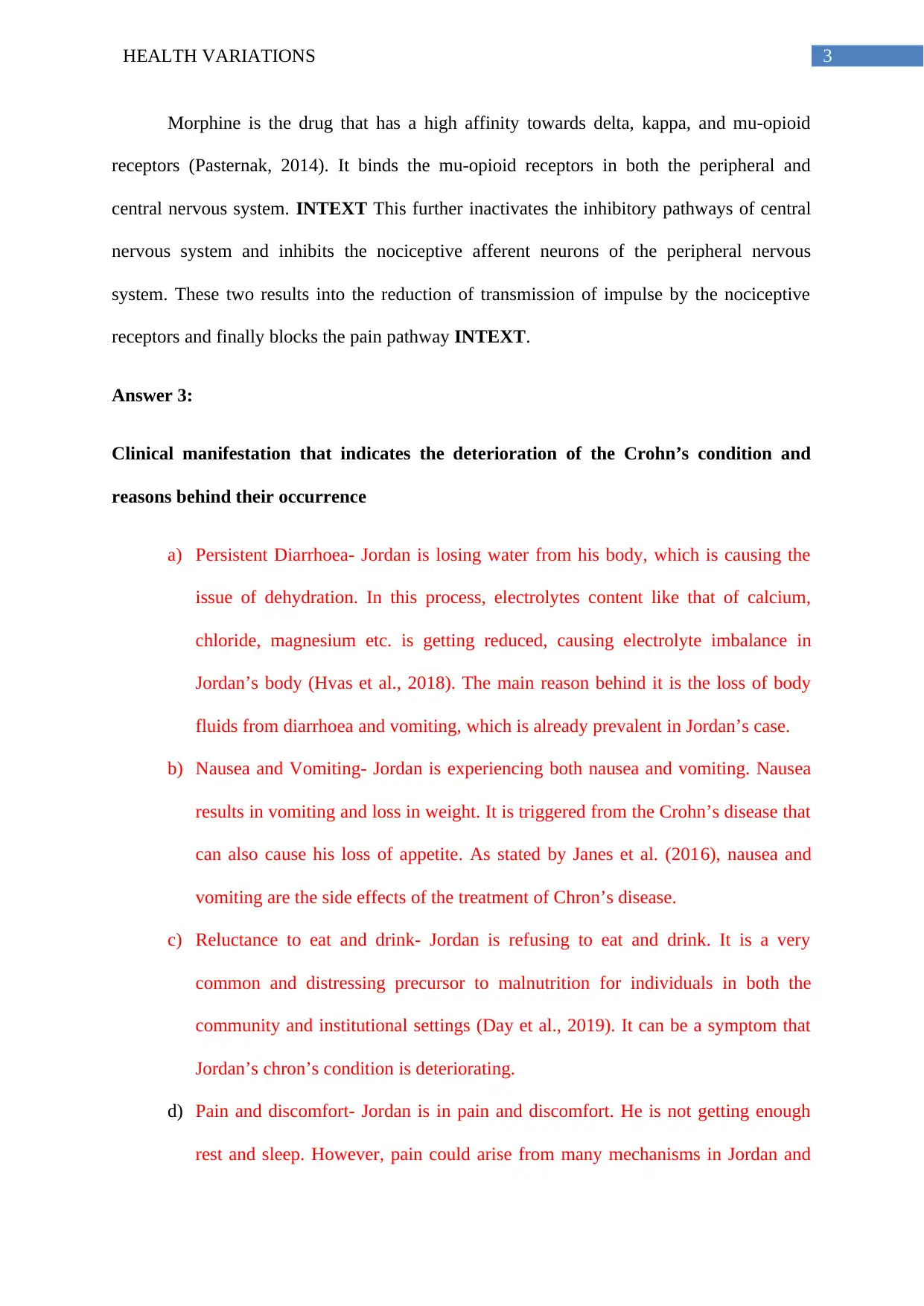
3HEALTH VARIATIONS
Morphine is the drug that has a high affinity towards delta, kappa, and mu-opioid
receptors (Pasternak, 2014). It binds the mu-opioid receptors in both the peripheral and
central nervous system. INTEXT This further inactivates the inhibitory pathways of central
nervous system and inhibits the nociceptive afferent neurons of the peripheral nervous
system. These two results into the reduction of transmission of impulse by the nociceptive
receptors and finally blocks the pain pathway INTEXT.
Answer 3:
Clinical manifestation that indicates the deterioration of the Crohn’s condition and
reasons behind their occurrence
a) Persistent Diarrhoea- Jordan is losing water from his body, which is causing the
issue of dehydration. In this process, electrolytes content like that of calcium,
chloride, magnesium etc. is getting reduced, causing electrolyte imbalance in
Jordan’s body (Hvas et al., 2018). The main reason behind it is the loss of body
fluids from diarrhoea and vomiting, which is already prevalent in Jordan’s case.
b) Nausea and Vomiting- Jordan is experiencing both nausea and vomiting. Nausea
results in vomiting and loss in weight. It is triggered from the Crohn’s disease that
can also cause his loss of appetite. As stated by Janes et al. (2016), nausea and
vomiting are the side effects of the treatment of Chron’s disease.
c) Reluctance to eat and drink- Jordan is refusing to eat and drink. It is a very
common and distressing precursor to malnutrition for individuals in both the
community and institutional settings (Day et al., 2019). It can be a symptom that
Jordan’s chron’s condition is deteriorating.
d) Pain and discomfort- Jordan is in pain and discomfort. He is not getting enough
rest and sleep. However, pain could arise from many mechanisms in Jordan and
Morphine is the drug that has a high affinity towards delta, kappa, and mu-opioid
receptors (Pasternak, 2014). It binds the mu-opioid receptors in both the peripheral and
central nervous system. INTEXT This further inactivates the inhibitory pathways of central
nervous system and inhibits the nociceptive afferent neurons of the peripheral nervous
system. These two results into the reduction of transmission of impulse by the nociceptive
receptors and finally blocks the pain pathway INTEXT.
Answer 3:
Clinical manifestation that indicates the deterioration of the Crohn’s condition and
reasons behind their occurrence
a) Persistent Diarrhoea- Jordan is losing water from his body, which is causing the
issue of dehydration. In this process, electrolytes content like that of calcium,
chloride, magnesium etc. is getting reduced, causing electrolyte imbalance in
Jordan’s body (Hvas et al., 2018). The main reason behind it is the loss of body
fluids from diarrhoea and vomiting, which is already prevalent in Jordan’s case.
b) Nausea and Vomiting- Jordan is experiencing both nausea and vomiting. Nausea
results in vomiting and loss in weight. It is triggered from the Crohn’s disease that
can also cause his loss of appetite. As stated by Janes et al. (2016), nausea and
vomiting are the side effects of the treatment of Chron’s disease.
c) Reluctance to eat and drink- Jordan is refusing to eat and drink. It is a very
common and distressing precursor to malnutrition for individuals in both the
community and institutional settings (Day et al., 2019). It can be a symptom that
Jordan’s chron’s condition is deteriorating.
d) Pain and discomfort- Jordan is in pain and discomfort. He is not getting enough
rest and sleep. However, pain could arise from many mechanisms in Jordan and
Paraphrase This Document
Need a fresh take? Get an instant paraphrase of this document with our AI Paraphraser
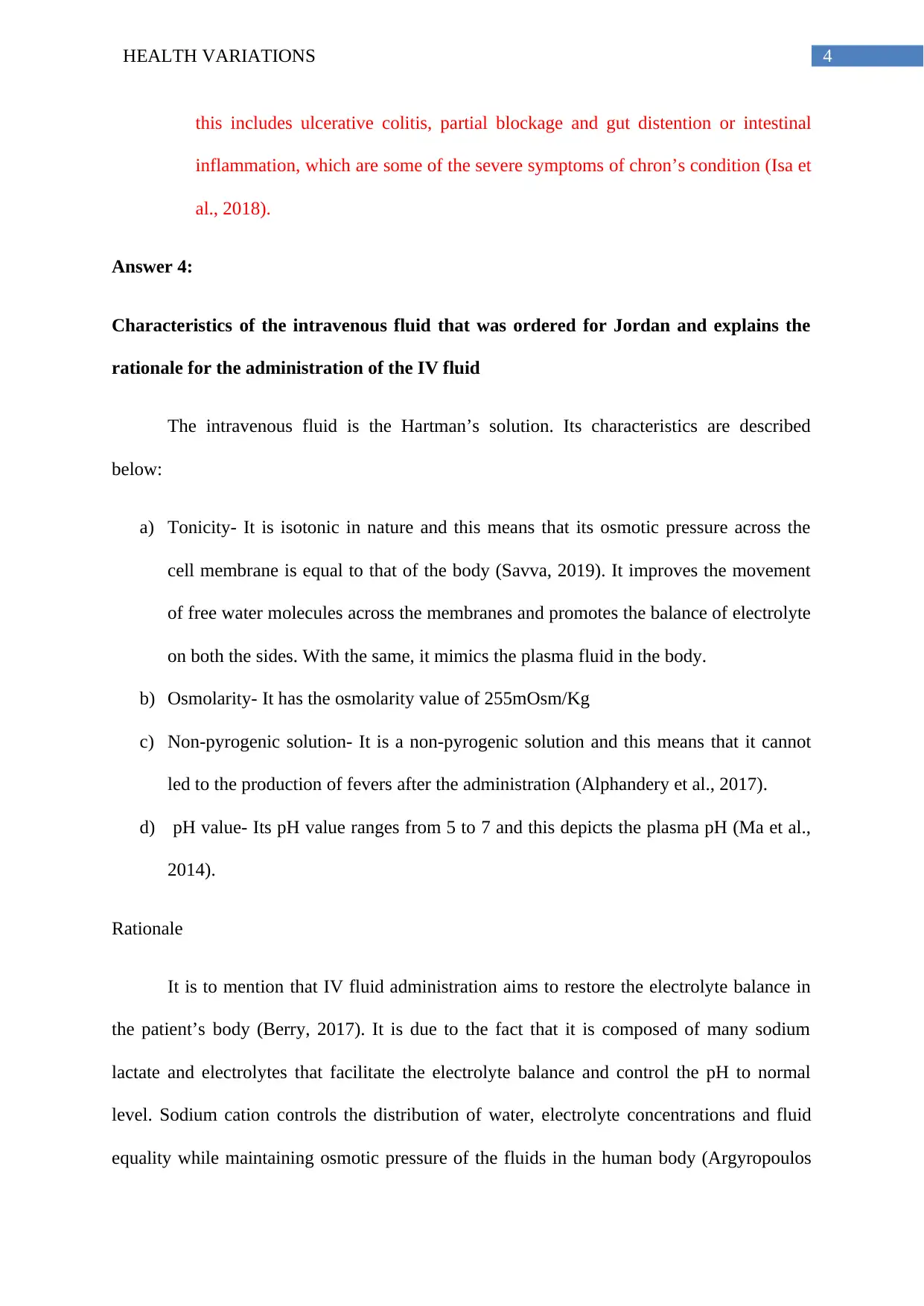
4HEALTH VARIATIONS
this includes ulcerative colitis, partial blockage and gut distention or intestinal
inflammation, which are some of the severe symptoms of chron’s condition (Isa et
al., 2018).
Answer 4:
Characteristics of the intravenous fluid that was ordered for Jordan and explains the
rationale for the administration of the IV fluid
The intravenous fluid is the Hartman’s solution. Its characteristics are described
below:
a) Tonicity- It is isotonic in nature and this means that its osmotic pressure across the
cell membrane is equal to that of the body (Savva, 2019). It improves the movement
of free water molecules across the membranes and promotes the balance of electrolyte
on both the sides. With the same, it mimics the plasma fluid in the body.
b) Osmolarity- It has the osmolarity value of 255mOsm/Kg
c) Non-pyrogenic solution- It is a non-pyrogenic solution and this means that it cannot
led to the production of fevers after the administration (Alphandery et al., 2017).
d) pH value- Its pH value ranges from 5 to 7 and this depicts the plasma pH (Ma et al.,
2014).
Rationale
It is to mention that IV fluid administration aims to restore the electrolyte balance in
the patient’s body (Berry, 2017). It is due to the fact that it is composed of many sodium
lactate and electrolytes that facilitate the electrolyte balance and control the pH to normal
level. Sodium cation controls the distribution of water, electrolyte concentrations and fluid
equality while maintaining osmotic pressure of the fluids in the human body (Argyropoulos
this includes ulcerative colitis, partial blockage and gut distention or intestinal
inflammation, which are some of the severe symptoms of chron’s condition (Isa et
al., 2018).
Answer 4:
Characteristics of the intravenous fluid that was ordered for Jordan and explains the
rationale for the administration of the IV fluid
The intravenous fluid is the Hartman’s solution. Its characteristics are described
below:
a) Tonicity- It is isotonic in nature and this means that its osmotic pressure across the
cell membrane is equal to that of the body (Savva, 2019). It improves the movement
of free water molecules across the membranes and promotes the balance of electrolyte
on both the sides. With the same, it mimics the plasma fluid in the body.
b) Osmolarity- It has the osmolarity value of 255mOsm/Kg
c) Non-pyrogenic solution- It is a non-pyrogenic solution and this means that it cannot
led to the production of fevers after the administration (Alphandery et al., 2017).
d) pH value- Its pH value ranges from 5 to 7 and this depicts the plasma pH (Ma et al.,
2014).
Rationale
It is to mention that IV fluid administration aims to restore the electrolyte balance in
the patient’s body (Berry, 2017). It is due to the fact that it is composed of many sodium
lactate and electrolytes that facilitate the electrolyte balance and control the pH to normal
level. Sodium cation controls the distribution of water, electrolyte concentrations and fluid
equality while maintaining osmotic pressure of the fluids in the human body (Argyropoulos

5HEALTH VARIATIONS
et al., 2016). Chloride on the other hand, maintains the properties of acid-base of the cells
along with the electrodynamics and isotonicity nature of the cell. The potassium ions further
regulate the conduction of nerves and muscle contraction while improving the protein
synthesis and uses of carbohydrates.
et al., 2016). Chloride on the other hand, maintains the properties of acid-base of the cells
along with the electrodynamics and isotonicity nature of the cell. The potassium ions further
regulate the conduction of nerves and muscle contraction while improving the protein
synthesis and uses of carbohydrates.
⊘ This is a preview!⊘
Do you want full access?
Subscribe today to unlock all pages.

Trusted by 1+ million students worldwide
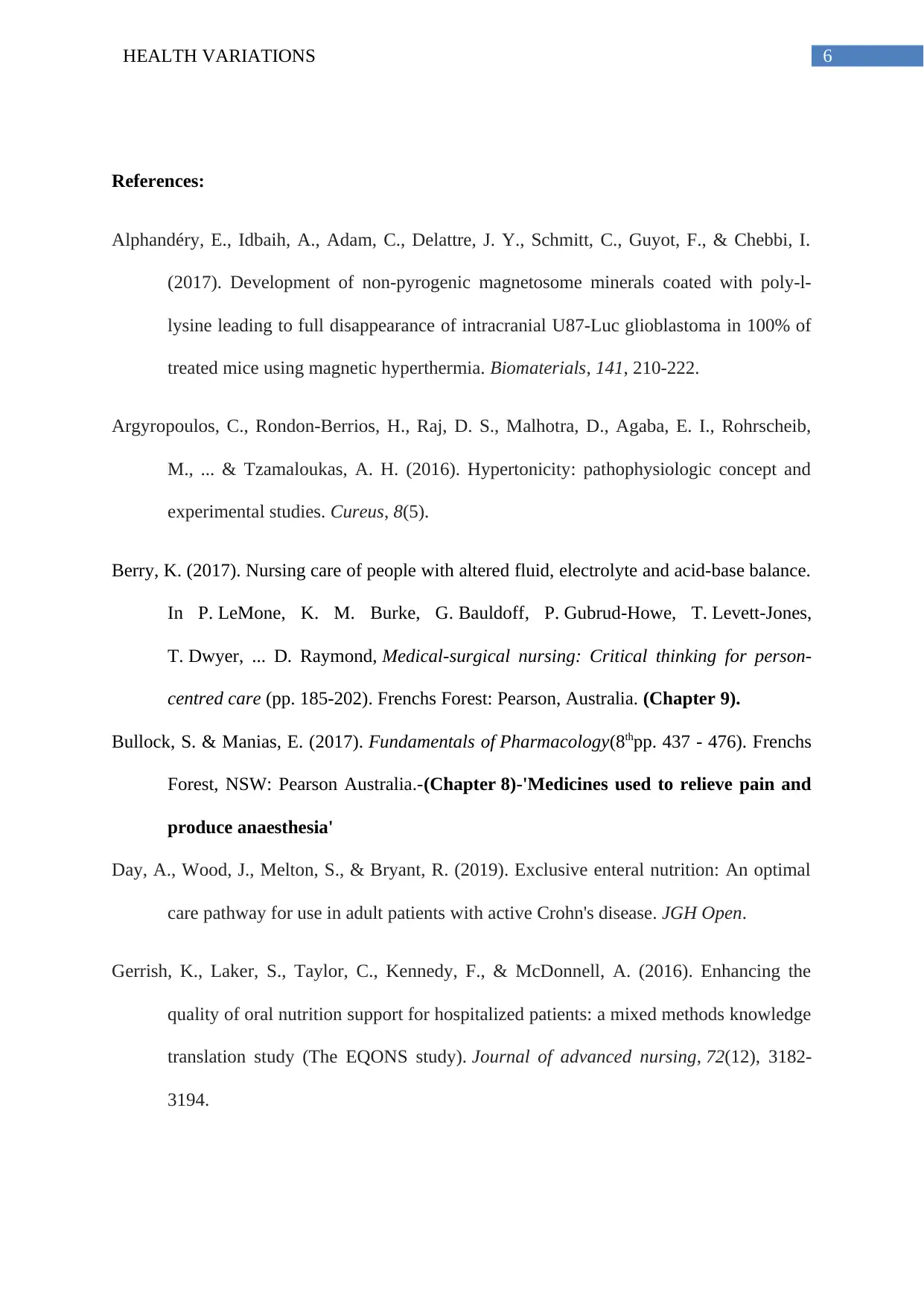
6HEALTH VARIATIONS
References:
Alphandéry, E., Idbaih, A., Adam, C., Delattre, J. Y., Schmitt, C., Guyot, F., & Chebbi, I.
(2017). Development of non-pyrogenic magnetosome minerals coated with poly-l-
lysine leading to full disappearance of intracranial U87-Luc glioblastoma in 100% of
treated mice using magnetic hyperthermia. Biomaterials, 141, 210-222.
Argyropoulos, C., Rondon-Berrios, H., Raj, D. S., Malhotra, D., Agaba, E. I., Rohrscheib,
M., ... & Tzamaloukas, A. H. (2016). Hypertonicity: pathophysiologic concept and
experimental studies. Cureus, 8(5).
Berry, K. (2017). Nursing care of people with altered fluid, electrolyte and acid-base balance.
In P. LeMone, K. M. Burke, G. Bauldoff, P. Gubrud-Howe, T. Levett-Jones,
T. Dwyer, ... D. Raymond, Medical-surgical nursing: Critical thinking for person-
centred care (pp. 185-202). Frenchs Forest: Pearson, Australia. (Chapter 9).
Bullock, S. & Manias, E. (2017). Fundamentals of Pharmacology(8thpp. 437 - 476). Frenchs
Forest, NSW: Pearson Australia.-(Chapter 8)-'Medicines used to relieve pain and
produce anaesthesia'
Day, A., Wood, J., Melton, S., & Bryant, R. (2019). Exclusive enteral nutrition: An optimal
care pathway for use in adult patients with active Crohn's disease. JGH Open.
Gerrish, K., Laker, S., Taylor, C., Kennedy, F., & McDonnell, A. (2016). Enhancing the
quality of oral nutrition support for hospitalized patients: a mixed methods knowledge
translation study (The EQONS study). Journal of advanced nursing, 72(12), 3182-
3194.
References:
Alphandéry, E., Idbaih, A., Adam, C., Delattre, J. Y., Schmitt, C., Guyot, F., & Chebbi, I.
(2017). Development of non-pyrogenic magnetosome minerals coated with poly-l-
lysine leading to full disappearance of intracranial U87-Luc glioblastoma in 100% of
treated mice using magnetic hyperthermia. Biomaterials, 141, 210-222.
Argyropoulos, C., Rondon-Berrios, H., Raj, D. S., Malhotra, D., Agaba, E. I., Rohrscheib,
M., ... & Tzamaloukas, A. H. (2016). Hypertonicity: pathophysiologic concept and
experimental studies. Cureus, 8(5).
Berry, K. (2017). Nursing care of people with altered fluid, electrolyte and acid-base balance.
In P. LeMone, K. M. Burke, G. Bauldoff, P. Gubrud-Howe, T. Levett-Jones,
T. Dwyer, ... D. Raymond, Medical-surgical nursing: Critical thinking for person-
centred care (pp. 185-202). Frenchs Forest: Pearson, Australia. (Chapter 9).
Bullock, S. & Manias, E. (2017). Fundamentals of Pharmacology(8thpp. 437 - 476). Frenchs
Forest, NSW: Pearson Australia.-(Chapter 8)-'Medicines used to relieve pain and
produce anaesthesia'
Day, A., Wood, J., Melton, S., & Bryant, R. (2019). Exclusive enteral nutrition: An optimal
care pathway for use in adult patients with active Crohn's disease. JGH Open.
Gerrish, K., Laker, S., Taylor, C., Kennedy, F., & McDonnell, A. (2016). Enhancing the
quality of oral nutrition support for hospitalized patients: a mixed methods knowledge
translation study (The EQONS study). Journal of advanced nursing, 72(12), 3182-
3194.
Paraphrase This Document
Need a fresh take? Get an instant paraphrase of this document with our AI Paraphraser
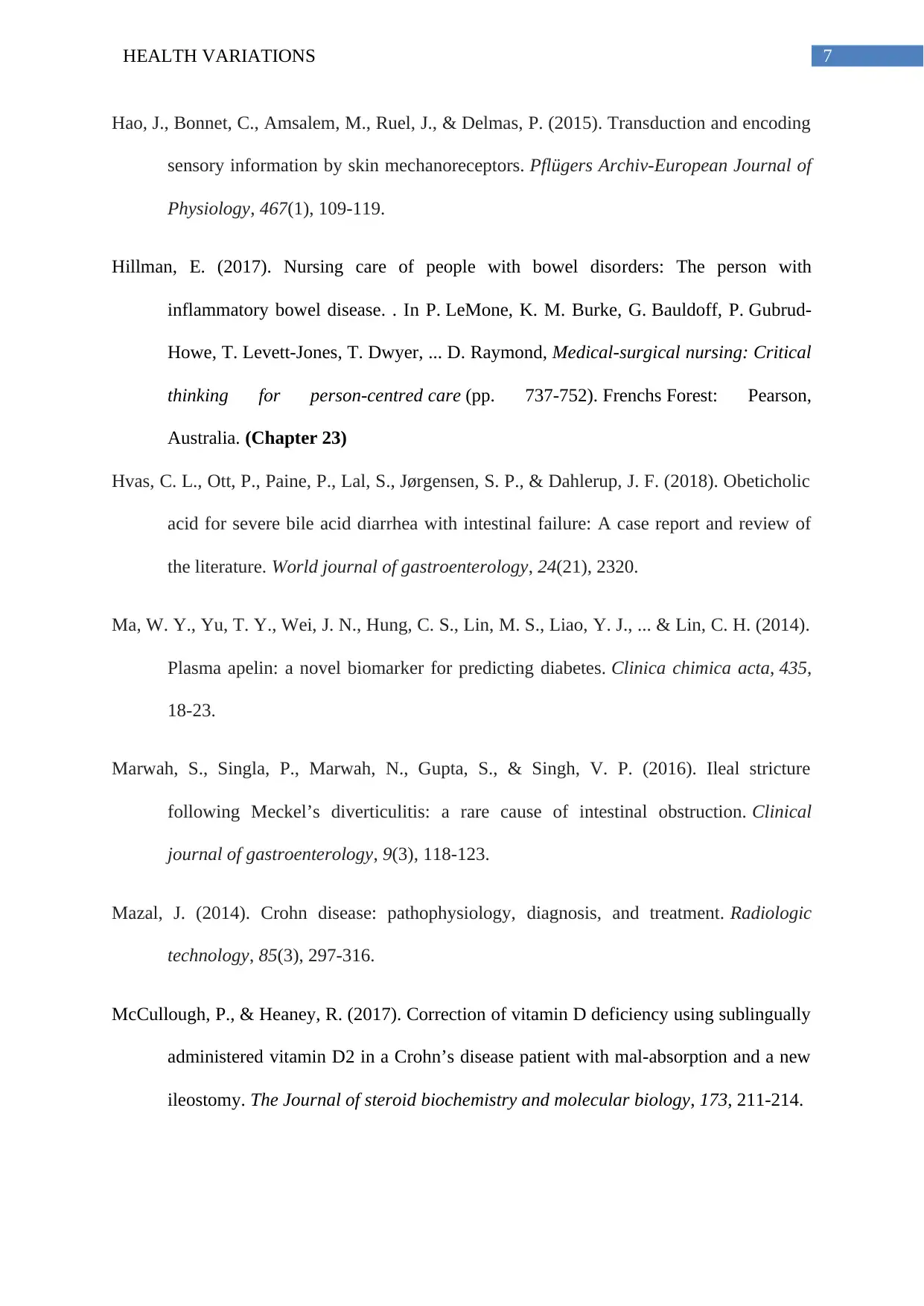
7HEALTH VARIATIONS
Hao, J., Bonnet, C., Amsalem, M., Ruel, J., & Delmas, P. (2015). Transduction and encoding
sensory information by skin mechanoreceptors. Pflügers Archiv-European Journal of
Physiology, 467(1), 109-119.
Hillman, E. (2017). Nursing care of people with bowel disorders: The person with
inflammatory bowel disease. . In P. LeMone, K. M. Burke, G. Bauldoff, P. Gubrud-
Howe, T. Levett-Jones, T. Dwyer, ... D. Raymond, Medical-surgical nursing: Critical
thinking for person-centred care (pp. 737-752). Frenchs Forest: Pearson,
Australia. (Chapter 23)
Hvas, C. L., Ott, P., Paine, P., Lal, S., Jørgensen, S. P., & Dahlerup, J. F. (2018). Obeticholic
acid for severe bile acid diarrhea with intestinal failure: A case report and review of
the literature. World journal of gastroenterology, 24(21), 2320.
Ma, W. Y., Yu, T. Y., Wei, J. N., Hung, C. S., Lin, M. S., Liao, Y. J., ... & Lin, C. H. (2014).
Plasma apelin: a novel biomarker for predicting diabetes. Clinica chimica acta, 435,
18-23.
Marwah, S., Singla, P., Marwah, N., Gupta, S., & Singh, V. P. (2016). Ileal stricture
following Meckel’s diverticulitis: a rare cause of intestinal obstruction. Clinical
journal of gastroenterology, 9(3), 118-123.
Mazal, J. (2014). Crohn disease: pathophysiology, diagnosis, and treatment. Radiologic
technology, 85(3), 297-316.
McCullough, P., & Heaney, R. (2017). Correction of vitamin D deficiency using sublingually
administered vitamin D2 in a Crohn’s disease patient with mal-absorption and a new
ileostomy. The Journal of steroid biochemistry and molecular biology, 173, 211-214.
Hao, J., Bonnet, C., Amsalem, M., Ruel, J., & Delmas, P. (2015). Transduction and encoding
sensory information by skin mechanoreceptors. Pflügers Archiv-European Journal of
Physiology, 467(1), 109-119.
Hillman, E. (2017). Nursing care of people with bowel disorders: The person with
inflammatory bowel disease. . In P. LeMone, K. M. Burke, G. Bauldoff, P. Gubrud-
Howe, T. Levett-Jones, T. Dwyer, ... D. Raymond, Medical-surgical nursing: Critical
thinking for person-centred care (pp. 737-752). Frenchs Forest: Pearson,
Australia. (Chapter 23)
Hvas, C. L., Ott, P., Paine, P., Lal, S., Jørgensen, S. P., & Dahlerup, J. F. (2018). Obeticholic
acid for severe bile acid diarrhea with intestinal failure: A case report and review of
the literature. World journal of gastroenterology, 24(21), 2320.
Ma, W. Y., Yu, T. Y., Wei, J. N., Hung, C. S., Lin, M. S., Liao, Y. J., ... & Lin, C. H. (2014).
Plasma apelin: a novel biomarker for predicting diabetes. Clinica chimica acta, 435,
18-23.
Marwah, S., Singla, P., Marwah, N., Gupta, S., & Singh, V. P. (2016). Ileal stricture
following Meckel’s diverticulitis: a rare cause of intestinal obstruction. Clinical
journal of gastroenterology, 9(3), 118-123.
Mazal, J. (2014). Crohn disease: pathophysiology, diagnosis, and treatment. Radiologic
technology, 85(3), 297-316.
McCullough, P., & Heaney, R. (2017). Correction of vitamin D deficiency using sublingually
administered vitamin D2 in a Crohn’s disease patient with mal-absorption and a new
ileostomy. The Journal of steroid biochemistry and molecular biology, 173, 211-214.
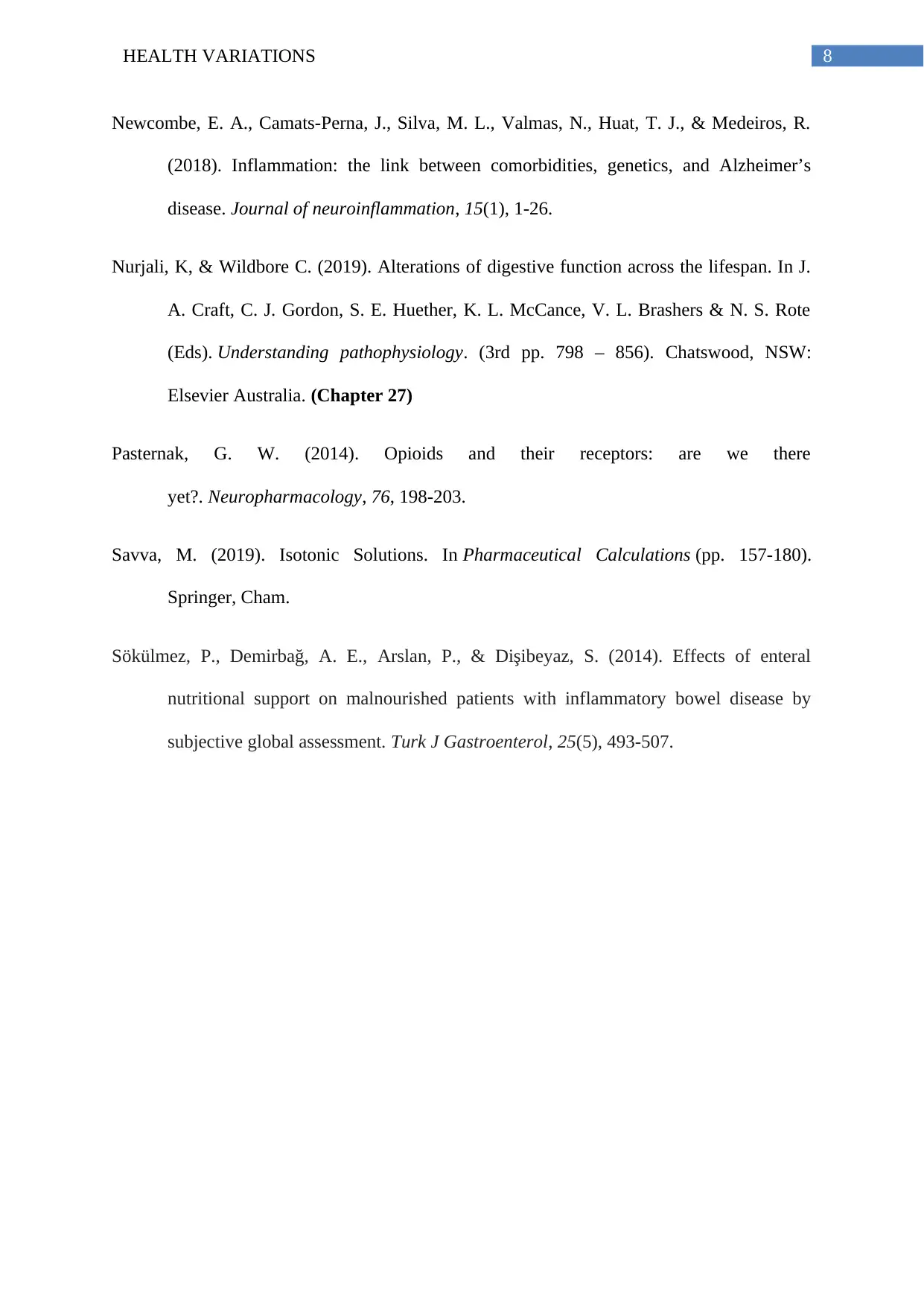
8HEALTH VARIATIONS
Newcombe, E. A., Camats-Perna, J., Silva, M. L., Valmas, N., Huat, T. J., & Medeiros, R.
(2018). Inflammation: the link between comorbidities, genetics, and Alzheimer’s
disease. Journal of neuroinflammation, 15(1), 1-26.
Nurjali, K, & Wildbore C. (2019). Alterations of digestive function across the lifespan. In J.
A. Craft, C. J. Gordon, S. E. Huether, K. L. McCance, V. L. Brashers & N. S. Rote
(Eds). Understanding pathophysiology. (3rd pp. 798 – 856). Chatswood, NSW:
Elsevier Australia. (Chapter 27)
Pasternak, G. W. (2014). Opioids and their receptors: are we there
yet?. Neuropharmacology, 76, 198-203.
Savva, M. (2019). Isotonic Solutions. In Pharmaceutical Calculations (pp. 157-180).
Springer, Cham.
Sökülmez, P., Demirbağ, A. E., Arslan, P., & Dişibeyaz, S. (2014). Effects of enteral
nutritional support on malnourished patients with inflammatory bowel disease by
subjective global assessment. Turk J Gastroenterol, 25(5), 493-507.
Newcombe, E. A., Camats-Perna, J., Silva, M. L., Valmas, N., Huat, T. J., & Medeiros, R.
(2018). Inflammation: the link between comorbidities, genetics, and Alzheimer’s
disease. Journal of neuroinflammation, 15(1), 1-26.
Nurjali, K, & Wildbore C. (2019). Alterations of digestive function across the lifespan. In J.
A. Craft, C. J. Gordon, S. E. Huether, K. L. McCance, V. L. Brashers & N. S. Rote
(Eds). Understanding pathophysiology. (3rd pp. 798 – 856). Chatswood, NSW:
Elsevier Australia. (Chapter 27)
Pasternak, G. W. (2014). Opioids and their receptors: are we there
yet?. Neuropharmacology, 76, 198-203.
Savva, M. (2019). Isotonic Solutions. In Pharmaceutical Calculations (pp. 157-180).
Springer, Cham.
Sökülmez, P., Demirbağ, A. E., Arslan, P., & Dişibeyaz, S. (2014). Effects of enteral
nutritional support on malnourished patients with inflammatory bowel disease by
subjective global assessment. Turk J Gastroenterol, 25(5), 493-507.
⊘ This is a preview!⊘
Do you want full access?
Subscribe today to unlock all pages.

Trusted by 1+ million students worldwide
1 out of 9
Related Documents
Your All-in-One AI-Powered Toolkit for Academic Success.
+13062052269
info@desklib.com
Available 24*7 on WhatsApp / Email
![[object Object]](/_next/static/media/star-bottom.7253800d.svg)
Unlock your academic potential
Copyright © 2020–2025 A2Z Services. All Rights Reserved. Developed and managed by ZUCOL.





